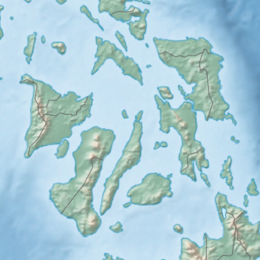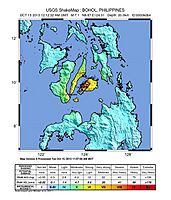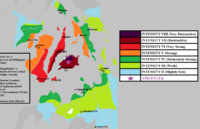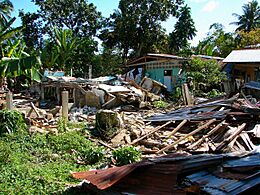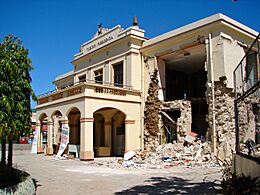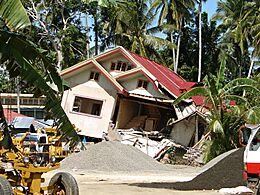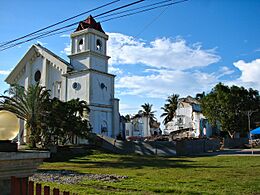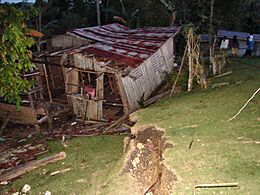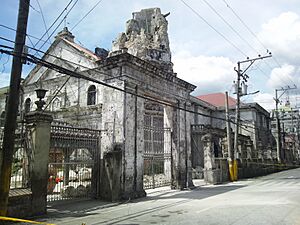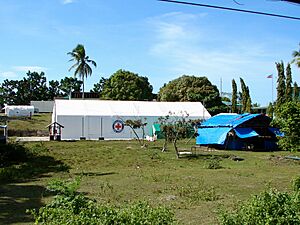2013 Bohol earthquake facts for kids
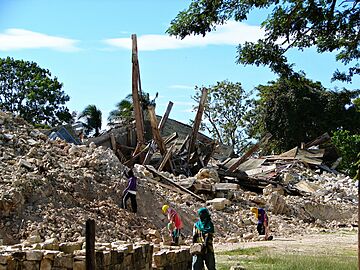
The rubble of the Church of Our Lady of Light in Loon, Bohol, the oldest and one of the largest in the province
|
|
| UTC time | 2013-10-15 00:12:32 |
|---|---|
| ISC event | 609078498 |
| USGS-ANSS | ComCat |
| Local date | October 15, 2013 |
| Local time | 8:12:31 PST |
| Duration | 34 seconds |
| Magnitude | Mw 7.2 |
| Depth | 12 km (7.5 mi) |
| Epicenter | 9°52′48″N 124°07′01″E / 9.880°N 124.117°E |
| Fault | North Bohol Fault |
| Type | Reverse |
| Areas affected | Philippines |
| Max. intensity | PEIS – VIII (Very Destructive) IX (Violent) |
| Peak acceleration | 0.7—0.8 g |
| Landslides |
|
| Aftershocks | 4,465 (122 felt) (as of December 31, 2013) |
| Casualties | 222 dead; 8 missing; 976 injured |
The 2013 Bohol earthquake happened on October 15, 2013, in Bohol, an island in the Central Visayas region of the Philippines. It was a very strong earthquake, measuring 7.2 on the moment magnitude scale. Its center was about 6 kilometers (4 miles) southwest of Sagbayan, and it started 12 kilometers (7.5 miles) deep inside the Earth.
This earthquake shook the entire Central Visayas region, especially Bohol and Cebu. People felt it across the whole Visayas area and as far away as Masbate in the north and Cotabato in southern Mindanao. It was the deadliest earthquake in the Philippines in 23 years.
Sadly, 222 people died, 8 went missing, and 976 people were hurt. More than 73,000 buildings were damaged, and over 14,500 of them were completely destroyed. The energy from this earthquake was like 32 of the bombs dropped on Hiroshima.
Just three weeks after the earthquake, a super typhoon named Haiyan (Yolanda) hit the region. Even though the typhoon didn't hit the earthquake-affected area directly, it forced many people who were still in temporary shelters back into evacuation centers. This made helping people in Bohol even harder.
Contents
How the Earthquake Happened
Earthquakes happen when parts of the Earth's crust suddenly move. This earthquake was caused by a fault line called the North Bohol Fault (NBF).
Understanding the Fault Line
Scientists first thought the earthquake was caused by a different fault. But later, the Philippine Institute of Volcanology and Seismology (PHIVOLCS) found that a new, previously unknown fault caused it. This fault runs across Bohol island.
The earthquake created a crack in the ground about 8 kilometers (5 miles) long. This crack showed that the land had moved, with one side pushing up over the other. In some places, the ground moved up by as much as 5 meters (16 feet)! This movement also caused a small waterfall in one creek.
Aftershocks and Tremors
After the main earthquake, many smaller earthquakes, called aftershocks, kept shaking Bohol and Cebu for several months. By December 6, 2013, over 4,000 aftershocks had been recorded. About 114 of these were strong enough for people to feel.
Earthquake Intensity Levels
The strength of an earthquake is measured by its intensity. This tells us how much shaking people felt and how much damage occurred in different places.
| PEIS reported intensities | |
|---|---|
| Intensity
Scales |
Location |
| VIII | Antequera; Buenavista; Carmen; Catigbian; Clarin; Inabanga; Loon; Maribojoc; Sagbayan; Tubigon (BOHOL) |
| VII | Tagbilaran City, Bohol; Cebu City; Lapu Lapu City; Mandaue City; Toledo City; Carcar City; Naga City (CEBU) |
| VI | Hinigaran, Negros Occidental; Dumaguete City; Siquijor Island |
| V | Iloilo City; La Carlota City; Guimaras Island; Abuyog, Leyte; Ozamis City; Sibulan, Negros Oriental; Camiguin Island; Gingoog, Misamis
Oriental; Cagayan de Oro City |
| IV | Roxas City; Masbate City; Bulusan, Sorsogon; Hinunangan; Tabon Tabon; San Pablo; Bato, Leyte; Patnungon, Antique; Dipolog City; Bacolod
City; Naval, Biliran; Bayawan City; Baybay, Southern Leyte; San Jose Antique; Guihulngan, Negros Oriental; Butuan; Tacloban City |
-
Shakemap for the event
Impact and Damage
The earthquake happened on a public holiday, Eid-al-Adha. This meant schools, some businesses, and offices were closed, which helped reduce the number of people hurt.
The total damage to public buildings, roads, bridges, and flood controls in Bohol and Cebu was about ₱2.25 billion (Philippine Pesos). Over 3.2 million people were affected by the quake, and more than 348,000 people had to leave their homes.
Damage in Bohol
Bohol was the most affected area.
- 209 people died, 877 were injured, and 8 were missing.
- The town of Loon had the most deaths (67).
- Almost 71,900 homes were damaged, with 14,480 completely destroyed.
- Many historic churches, like Loboc Church, Loon Church, and Maribojoc Church, collapsed or were badly damaged.
- In Carmen, a bell tower and an observation deck at the famous Chocolate Hills were destroyed. Some of the hills themselves were damaged by landslides.
- Many government buildings and schools were also damaged.
- 32 bridges and 13 road sections were damaged, making it hard for help to arrive.
- Electricity was cut off across the province.
- Damage in Bohol
Damage in Cebu
Cebu also felt strong shaking.
- 12 people died and 96 were injured.
- Over 1.9 million people were affected.
- A building at Pasil Fish Port collapsed, killing five people.
- The bell tower of the Basilica Minore del Santo Niño collapsed.
- The Cebu Provincial Capitol building was badly hit.
- Some hospitals were damaged.
- A stampede in a gym caused five deaths.
Other Islands Affected
Other islands in the Visayas, like Negros Occidental, Iloilo, Siquijor, and Leyte, also felt the earthquake. Some buildings were damaged, and a few people were injured or died in these areas.
Mindanao Impact
The earthquake was also felt in parts of Mindanao, like Cagayan de Oro and Butuan. However, there were no deaths or major damage reported in Mindanao.
Effects on Daily Life
Transportation Services
Flights at Cebu and Bohol airports were temporarily stopped to check if the buildings were safe. Mactan International Airport reopened later that day. Flights to and from Bohol were delayed for about three hours. Within two days, all seaports in Bohol and Cebu were back to normal.
Health Concerns
After the earthquake, many people in Bohol didn't have enough clean drinking water or proper toilets. This led to health problems like diarrhea. Hospitals and health centers were damaged, so makeshift medical areas had to be set up outside. Food supplies were also affected, and many markets couldn't open.
The constant aftershocks made people afraid to go back into damaged buildings. Many stayed in temporary shelters, which caused a lot of stress and worry.
Power and Water Supply
A week after the earthquake, one out of every five homes in Bohol still had no electricity. By November 3, almost all electricity was back. However, when Super Typhoon Haiyan hit, Bohol lost power again because its main electricity source in Leyte was damaged. It took several more weeks for power to be fully restored.
Water supply was also a big problem, especially in towns like Calape, Cortes, Loon, Maribojoc, and Sagbayan. By October 20, water was restored in 42 towns, but some areas still struggled.
Postponed Elections
Because of the widespread damage, the local government of Bohol asked to delay the barangay elections that were supposed to happen on October 28, 2013. The election commission agreed, saying it wasn't safe to hold elections in damaged buildings. The elections in Bohol were rescheduled for November 25.
See also
- List of earthquakes in 2013
- List of earthquakes in the Philippines
Images for kids


